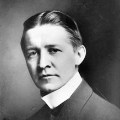
Bertram Grosvenor Goodhue (1869 – 1924)
Bertram Grosvenor Goodhue was an innovator who combined Gothic and Hispanic designs with modern ideas. He revolutionized church architecture by reawakening Medieval traditions, and his fanciful Spanish Churrigueresque buildings for the Panama-California Exposition brought new energy to Spanish Colonial Revival architecture in the United States.
Bertram Grosvenor Goodhue never attended college. Instead, at age fifteen he went to work in the New York office of Renwick, Aspinwall and Russell. In 1898, he formed his own partnership with Cram, Goodhue and Ferguson.
Later in his career, Goodhue moved beyond Gothic ornamentation to explore simple classical forms, designing landmark buildings such as the Nebraska State Capitol. He later adopted a lighter, Romanesque style. Today Goodhue is considered an American modernist.
Notable Buildings:
1915: Panama-California Exposition Buildings, San Diego, California
1922: Nebraska State Capitol building
1924: National Academy of Sciences Building
1924: Master Plan for the Califorinia Institute of Technology